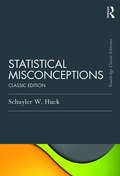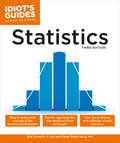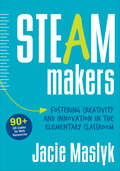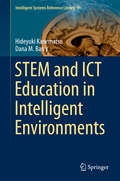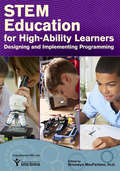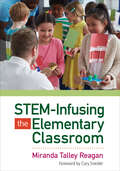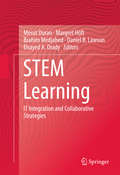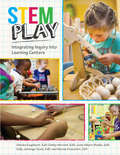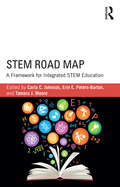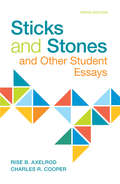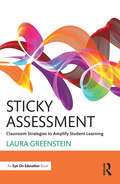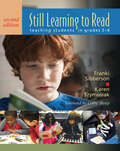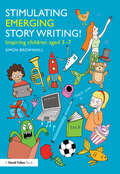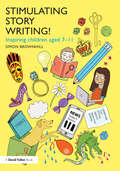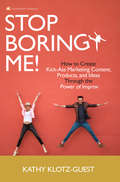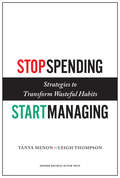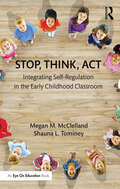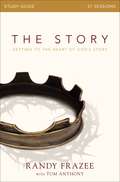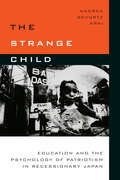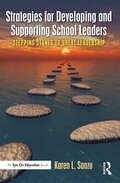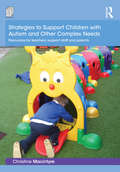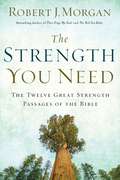- Table View
- List View
Statistical Misconceptions: Classic Edition (Psychology Press & Routledge Classic Editions)
by Schuyler W. HuckThis engaging book helps readers identify and then discard 52 misconceptions about data and statistical summaries. The focus is on major concepts contained in typical undergraduate and graduate courses in statistics, research methods, or quantitative analysis. Interactive Internet exercises that further promote undoing the misconceptions are found on the book's website. The author’s accessible discussion of each misconception has five parts: The Misconception - a brief description of the misunderstanding Evidence that the Misconception Exists – examples and claimed prevalence Why the Misconception is Dangerous – consequence of having the misunderstanding Undoing the Misconception - how to think correctly about the concept Internet Assignment - an interactive activity to help readers gain a firm grasp of the statistical concept and overcome the misconception. The book's statistical misconceptions are grouped into 12 chapters that match the topics typically taught in introductory/intermediate courses. However, each of the 52 discussions is self-contained, thus allowing the misconceptions to be covered in any order without confusing the reader. Organized and presented in this manner, the book is an ideal supplement for any standard textbook. An ideal supplement for undergraduate and graduate courses in statistics, research methods, or quantitative analysis taught in psychology, education, business, nursing, medicine, and the social sciences. The book also appeals to independent researchers interested in undoing their statistical misconceptions.
Statistics, 3E (Idiot's Guides)
by Robert A. Donnelly Fatma Abdel-RaoufStatistics is a class that is required in many college majors, and it&’s an increasingly popular Advanced Placement (AP) high school course. In addition to math and technical students, many business and liberal arts students are required to take it as a fundamental component of their majors. A knowledge of statistical interpretation is vital for many careers. Idiot&’s Guides®: Statistics explains the fundamental tenets in language anyone can understand. Content includes: - Calculating descriptive statistics. - Measures of central tendency: mean, median, and mode. - Probability. - Variance analysis. - Inferential statistics. - Hypothesis testing. - Organizing data into statistical charts and tables.
STEAM Makers: Fostering Creativity and Innovation in the Elementary Classroom
by Dr Jacie MaslykBuild the essential 4—creativity, collaboration, communication, and critical thinking! Go beyond theory and learn how to systematically integrate STEAM and Maker spaces that prepare students for real-world experiences. This engaging resource outlines step-by-step processes to help anyone start their STEAM and Maker journey. Includes charts, checklists, web links, and profiles to help you make meaningful subject area connections and tap your students’ natural curiosity. You’ll learn to: Integrate STEAM and Making into daily practice Differentiate instruction for all learners Align with core standards and The Next Generation Science Standards
STEAM Makers: Fostering Creativity and Innovation in the Elementary Classroom
by Dr Jacie MaslykBuild the essential 4—creativity, collaboration, communication, and critical thinking! Go beyond theory and learn how to systematically integrate STEAM and Maker spaces that prepare students for real-world experiences. This engaging resource outlines step-by-step processes to help anyone start their STEAM and Maker journey. Includes charts, checklists, web links, and profiles to help you make meaningful subject area connections and tap your students’ natural curiosity. You’ll learn to: Integrate STEAM and Making into daily practice Differentiate instruction for all learners Align with core standards and The Next Generation Science Standards
STEM and ICT Education in Intelligent Environments
by Hideyuki Kanematsu Dana M. BarryThis book combines information communication technology (ICT) with the creative interdisciplinary teaching approach known as STEM (science, technology, engineering and mathematics). It introduces STEM and Creative Education and shows (through examples and creative activities) the importance and impact that ICT has for STEM and modern education. The book describes the audio visual classroom, the use of the Internet, Social Networking and STEM and provides STEM lessons for both the real and virtual worlds. Instructors will find this unique textbook to be very useful with students, of various ages, in creative education and engineering classes. This special book offers something for everyone. It serves as a guide for teachers in charge of science fairs and creative classes, especially those which require STEM education. It also includes activities to help develop creative thinking and problem-solving skills and prepares students who plan to become teachers and mentors of the future. Readers in general can simultaneously enjoy and learn about ICT's impact on STEM and modern education. In addition, e-learning designers and administrators who want to introduce e-learning systems into their organizations can refer to this book as a reference and a resource. The book complements most e-learning and ICT education books which generally focus too much on technical issues.
STEM Education for High-Ability Learners
by Bronwyn MacfarlaneSTEM Education for High-Ability Learners: Designing and Implementing Programming focuses on the rigorous articulation of quality STEM education programming to develop STEM talent among high-ability and gifted learners. The intent of this book is to provide a comprehensive resource for educators designing and implementing each of the supports within STEM education by providing a discussion of each critical component for inclusion in a planned, coherent, and high-quality sequenced system. This edited volume provides a cutting-edge discussion of best practices for delivering STEM education by experts in the field. The contributing authors provide a differentiated discussion and recommendations for the learning experiences of gifted students in STEM education programs.
STEM-Infusing the Elementary Classroom
by Miranda Talley ReaganMake learning relevant with STEM essential questions This engaging, teacher-friendly guide helps teachers quickly and confidently infuse STEM concepts into all content areas. Real-world vignettes, sample lesson templates, discussion questions and immediately applicable action steps help you seamlessly promote college and career ready skills. Use this inspiring guide to: Deepen all content areas, including English/ Language Arts Promote the 4Cs: communication, collaboration, critical thinking, and creativity Require students to take risks to solve problems Differentiate instruction and scaffold support Expand students’ specific measurable capabilities Incorporate design skills into the curricula Save valuable time and confidently develop standards-aligned STEM projects in all content areas!
STEM-Infusing the Elementary Classroom
by Miranda Talley ReaganMake learning relevant with STEM essential questions This engaging, teacher-friendly guide helps teachers quickly and confidently infuse STEM concepts into all content areas. Real-world vignettes, sample lesson templates, discussion questions and immediately applicable action steps help you seamlessly promote college and career ready skills. Use this inspiring guide to: Deepen all content areas, including English/ Language Arts Promote the 4Cs: communication, collaboration, critical thinking, and creativity Require students to take risks to solve problems Differentiate instruction and scaffold support Expand students’ specific measurable capabilities Incorporate design skills into the curricula Save valuable time and confidently develop standards-aligned STEM projects in all content areas!
STEM Learning
by Elsayed A. Orady Daniel B. Lawson Brahim Medjahed Margret Höft Mesut DuranThis book reports the results of a three-year research program funded by the National Science Foundation which targeted students and teachers from four Detroit high schools in order for them to learn, experience, and use IT within the context of STEM (IT/STEM), and explore 21st century career and educational pathways. The book discusses the accomplishment of these goals through the creation of a Community of Designers-- an environment in which high school students and teachers, undergraduate/graduate student assistants, and STEM area faculty and industry experts worked together as a cohesive team. The program created four project-based design teams, one for each STEM area. Each team had access to two year-round IT/STEM enrichment experiences to create high-quality learning projects, strategies, and curriculum models. These strategies were applied in after school, weekend, and summer settings through hands-on, inquiry-based activities with a strong emphasis on non-traditional approaches to learning and understanding. The book represents the first comprehensive description and analysis of the research program and suggests a plan for future development and refinement.
STEM Play: Integrating Inquiry into Learning Centers
by Deirdre Englehart Debby Mitchell Junie Albers-Biddle Kelly Jennings-Towle Marnie ForestieriMost early childhood teachers are using learning centers in the classroom, but do not approach them in ways that fully support a variety of learning opportunities. This book approaches learning centers through the STEM (science, technology, engineering, math) lens, and shares how themes can be integrated into centers to promote creativity and higher-level thinking. STEM Play provides varied activities for the most common centers: Art, blocks, dramatic play, literacy, math, science, music and movement. Full of beautiful, full-color photos that show the activities in real early childhood classrooms, teachers can easily use the book’s ideas immediately in their curriculum. STEM Play also includes a “How To” section for teachers who wish to expand on the STEM focus and use themed activities in their learning centers.
STEM Road Map: A Framework for Integrated STEM Education
by Carla C. Johnson Erin E. Peters-Burton Tamara J. MooreSTEM Road Map: A Framework for Integrated STEM Education is the first resource to offer an integrated STEM curricula encompassing the entire K-12 spectrum, with complete grade-level learning based on a spiraled approach to building conceptual understanding. A team of over thirty STEM education professionals from across the U.S. collaborated on the important work of mapping out the Common Core standards in mathematics and English/language arts, the Next Generation Science Standards performance expectations, and the Framework for 21st Century Learning into a coordinated, integrated, STEM education curriculum map. The book is structured in three main parts—Conceptualizing STEM, STEM Curriculum Maps, and Building Capacity for STEM—designed to build common understandings of integrated STEM, provide rich curriculum maps for implementing integrated STEM at the classroom level, and supports to enable systemic transformation to an integrated STEM approach. The STEM Road Map places the power into educators’ hands to implement integrated STEM learning within their classrooms without the need for extensive resources, making it a reality for all students.
Sticks and Stones: And Other Student Essays
by Rise B. Axelrod Charles R. CooperThis unique collection of essays written by students around the country offers diverse and accessible models for the writing assignments in Part 1 of The St. Martin's Guide to Writing. The chapters in Sticks and Stones correspond to the chapters in Part One of the Guide. Packaged free with the Guide
Sticky Assessment: Classroom Strategies to Amplify Student Learning
by Laura GreensteinSticky Assessment is a straightforward guide to assessment, designed to demystify assessment and to give teachers the tools they need become better assessors. Translating the latest research into a concise and practical volume, this book helps teachers to monitor student learning, make assessment engaging and meaningful for students, and to use assessment that improves rather than merely measures learning outcomes. With examples from classroom teachers and exercises designed to help teachers think through their processes, this book will be an invaluable and lasting resource for classroom teachers.
Still Learning to Read: Teaching Students in Grades 3–6
by Franki Sibberson Karen SzymusiakAuthors Franki Sibberson and Karen Szymusiak are back with an updated version of Still Learning to Read: Teaching Students in Grades 3-6, 2nd Edition. In the years since the first edition, prevalence of testing and Common Core State Standards have redefined requirements and what is expected of both teachers and students.This new edition focuses on the needs of students in grades 3-6 in for the following areas: reading workshops, read-alouds, classroom design, digital tools, fiction and nonfiction, and close reading. The authors examine current trends in literacy and introduce a new section on intentional instructional planning, as well as a new chapter on scaffolding for reading nonfiction. Expanded examples of lessons and routines to promote deeper thinking about learning are also included.In Still Learning to Read, you'll also find online videos that provide insight into classrooms. Students make book choices, work in small groups, and discuss their reading notebooks. Finally, updated and expanded book lists, recommendations for digital tools, lesson cycles, and sections for school leaders round out this foundational resource.
Stimulating Emerging Story Writing!: Inspiring children aged 3–7
by Simon BrownhillStimulating Emerging Story Writing! Inspiring Children aged 3-7 offers innovative and exciting ways to inspire young children to want to create stories and develop their emerging story writing skills. This practical guide offers comprehensive and informed support for professionals to effectively engage ‘child authors’ in stimulating story writing activities. Packed full of story ideas, resource suggestions and practical activities, the book explores the various ways professionals can help young children to develop the six key elements of story, these being character, setting, plot, conflict, resolution and ending. All of the ideas in the book are designed to support a setting’s daily writing provision such as mark making opportunities, role play and using simple open ended play resources. Separated into two sections and with reference to the EYFS and Key Stage 1 curricula, this timely new text provides practitioners with tried and tested strategies and ideas that can be used with immediate effect. Chapters include: Creating Characters The Plot Thickens Inspired Ideas Resourcing the Story Stimulation This timely new text is the perfect guide for inspiring young children aged 3-7 in the classroom and will be an essential resource for practitioners, teachers and students on both early years and teacher training courses.
Stimulating Story Writing!: Inspiring children aged 7-11
by Simon BrownhillStimulating Story Writing! Inspiring Children aged 7-11 offers innovative and exciting ways to inspire children to want to create stories and develop their story writing skills. This practical guide offers comprehensive and informed support for professionals to effectively engage ‘child authors’ in stimulating story writing activity. Packed full of story ideas, resource suggestions and practical activities, the book explores various ways professionals can help children to develop the six key elements of story, these being character, setting, plot, conflict, resolution and ending. All of the ideas in the book are designed to complement and enrich existing writing provision in classrooms with strategies such as role play, the use of different technologies, and using simple open ended resources as story stimuli. Separated into two sections and with reference to the Key Stage 2 curricula, this timely new text provides professionals with tried and tested strategies and ideas that can be used with immediate effect. Chapters include: • Creating Characters • The Plot Thickens • Inspired Ideas • Resourcing the Story Stimulation This timely new text is the perfect guide for inspiring children aged 7-11 in the classroom and will be an essential resource for teachers and students on teacher training courses.
Stop Boring Me!: How to Create Kick-Ass Marketing Content, Products and Ideas Through the Power of Improv
by Kathy Klotz-GuestComing up constantly with a steady stream of marketing content, stories, and ideas that inspire excitement, interest and banish boring can be challenging. Your content-weary audience is saying "Stop Boring Me!" You cannot connect meaningfully with your audience if you bore them. There's just too much content chasing too little mindshare today. And most business marketing stinks because it is transactional, superficial and not human. The good news: it doesn't have to be that way because everyone is creative. Your inner kid is smart because it knows how to play. What if you could create engaging marketing content and storytelling, and generate kick-ass, fun and relevant ideas for stories, articles, branding, social media campaigns, sales presentations, and even new products? Well there is a fun way to do exactly that: by applying key concepts from the world of improvisation. Don't worry - this is not about theatricality, so you don't have to perform. It is about playfulness, however, and unleashing your inner kid. Bringing key concepts from the improvisation stage to your marketing, sales, branding and products page - or business stage, if you like - can help you, your team, your company and your business generate ideas that kick boring to the curb. While this book will help you be more funny, it's focused on fun as a creative catalyst for content idea orgasms: when different things come together in a fresh, human and engaging way that makes you and your audience say "aww yeah!" The first half of the book centers on how to use key improv concepts to craft and tell better stories for sales, social media, articles, presentations, content, and other story-related contexts. The second half of the book is all about innovating massively creative marketing ideas for products, content, campaigns, customer service, sales processes, you name it. While this book was written primarily for marketing people who have to create content, tell stories, make presentations; anyone in the idea-generation business (and who isn't) can use the tips in this book. Whether you are in marketing, sales, HR, product or customer service, these exercises will help you innovate and unleash more creative awesome into your work. Here is to more idea orgasms for you and your audience.
Stop Spending, Start Managing: Strategies to Transform Wasteful Habits
by Tanya Menon Leigh ThompsonToo often, managers spend money to solve problems at work, whether that means hiring outside consultants, investing in new software to fix communication issues, or bribing employees with cash to motivate them. But many managers are surprised when the problem they tried to solve reappears a few months, weeks, or even days later. The money is gone, but the problem is still there. These costs can add up, particularly when you consider the additional loss to your company in wasted time, energy, and resources when you don’t solve problems effectively. Tanya Menon and Leigh Thompson, experts in how organizations work, have developed a framework to help you understand why you fall into this trap, and how to escape it. Five psychologies—each of which substitutes spending for your own powers of management—lead to wasteful spending: 1. Mindless spending: throwing money at a problem to avoid thinking about it; 2. Ego spending: squandering resources to make yourself look good; 3. Please-like-me spending: wasting time and money to avoid conflict; 4. Talk-to-me spending: buying expensive technologies to help people communicate; and 5. Follow-me spending: using financial incentives to motivate people To break these habits, Menon and Thompson show how you can use your smarts as a manager to find solutions. By consciously observing waste and identifying hidden value, widening your mind-set beyond ego, courageously negotiating with others, encouraging meaningful interaction, and transforming people with positive values and relationships rather than cash, you can overcome these psychological barriers and find the value that already exists in your
Stop, Think, Act: Integrating Self-Regulation in the Early Childhood Classroom
by Megan M. McClelland Shauna L. TomineyStop, Think, Act: Integrating Self-regulation in the Early Childhood Classroom offers early childhood teachers the latest research and a wide variety of hands-on activities to help children learn and practice self-regulation techniques. Self-regulation in early childhood leads to strong academic performance, helps students form healthy friendships, and gives them the social and emotional resources they need to face high-stress situations throughout life. The book takes you through everything you need to know about using self-regulation principles during circle time, in literacy and math instruction, and during gross motor and outdoor play. Each chapter includes a solid research base as well as practical, developmentally-appropriate games, songs, and strategies that you can easily incorporate in your own classroom. With Stop, Think, Act, you’ll be prepared to integrate self-regulation into every aspect of the school day.
The Story Study Guide: Getting to the Heart of God's Story
by Randy Frazee Tom AnthonyThe Story group Bible study provides groups of all sizes the opportunity to discuss and apply what they experience during the 31-week The Story church campaign.To understand the Bible, says Frazee, you need bifocal lenses, because two perspectives are involved. The Lower Story, our story, is actually many stories of men and women interacting with God in the daily course of life.The Upper Story is God’s story, the tale of his great, overarching purpose that puts the individual stories together like panels in one unified mural.In 31 sessions, The Story video-based group study opens your eyes to God’s master plan unfolding in the lives of the Bible’s characters and in your own life.Discover the heart of God’s Upper Story, and the joy that comes as you align your story with God’s. The Story Study Guide and DVD (sold separately) are designed for use by groups of all sizes, including small groups and Sunday school and adult education classes.Designed for use with The Story Adult Curriculum Study DVD (9780310329527) sold separately.
The Strange Child: Education and the Psychology of Patriotism in Recessionary Japan
by Andrea Gevurtz AraiThe Strange Child examines how the Japanese financial crisis of the 1990s gave rise to "the child problem," a powerful discourse of social anxiety that refocused concerns about precarious economic futures and shifting ideologies of national identity onto the young. Andrea Arai's ethnography details the different forms of social and cultural dislocation that erupted in Japan starting in the late 1990s. Arai reveals the effects of shifting educational practices; increased privatization of social services; recessionary vocabulary of self-development and independence; and the neoliberalization of patriotism. Arai argues that the child problem and the social unease out of which it emerged provided a rationale for reimagining governance in education, liberalizing the job market, and a new role for psychology in the overturning of national-cultural ideologies. The Strange Child uncovers the state of nationalism in contemporary Japan, the politics of distraction around the child, and the altered life conditions of--and alternatives created by--the recessionary generation.
Strategies for Developing and Supporting School Leaders: Stepping Stones to Great Leadership
by Karen L. SanzoStrategies for Developing and Supporting School Leaders assists personnel in school districts to deliver appropriate development and support practices for aspiring and current school leaders. This book explores a variety of research-based and best-practice processes that can be implemented in school districts to prepare leaders to meet the technical and adaptive demands of school leadership and the needs of a diverse student population. Sanzo lays out a cohesive framework of key processes and activities that range from the very simple and immediately implementable, to the more complex and nuanced. Providing both the "how," and "why," this important resource shares ideas, strategies, tools, and systems to develop effective and meaningful professional learning opportunities to help promote highly effective schools and districts.
Strategies to Support Children with Autism and Other Complex Needs: Resources for teachers, support staff and parents
by Christine MacintyreWorking with young children on the autistic spectrum and supporting them as they learn can be fascinating, challenging, often overwhelmingly difficult, but more than anything else, hugely rewarding. Strategies to Support Children with Autism and other Complex Needs bridges the gap between explaining what autism is and finding ways to interact through having a balance of play activities interspersed with more formal teaching of skills of everyday living. This highly practical text provides a bank of strategies that are specially designed to be matched to the developmental status of each child. These strategies are endorsed by academics who have monitored the children’s responses in communicating, pretending, playing, moving, and singing and describe how the children have responded positively over time. This book covers a variety of topics such as: The importance of play for enhancing learning for children with autism and other complex needs Evaluating different ways of developing communication Transferring learning from one environment to another to aid memorizing. Understanding the impact of sensory hypo and hyperactivity on children’s learning. Developing a ‘Theory of Mind’ The importance of movement, music and having fun Observation and assessment schedules are provided, along with clear and helpful evaluation forms which show staff in primary and early years settings how children on the autistic spectrum can be helped to make meaningful and encouraging progress. This text is an vital read for any practitioners working with children on the autistic spectrum or with complex learning difficulties.
The Strength You Need: The Twelve Great Strength Passages of the Bible
by Robert MorganWhy are we feeling so depleted when God has promised us strength equal to our days? Pastor Robert Morgan leads a busy life as a pastor and is also a multitasking caregiver to his disabled wife. Most days he feels exhausted, yet over time God has shown him how to build himself up when he's worn himself out. He has learned to fully embrace Psalm 84, as he moves from strength to strength. The valleys and the weaknesses are inevitable. Our task is to embrace these as we wait for God to take us to our next time of strength. After reviewing the 232 occurrences of the word strength in Scripture, Pastor Robert discovered twelve clear passages that drop anchor in God's Sea of Strength. Among the kinds of strength available to every believer are: Lifelong Strength: your strength will equal your days (Deuteronomy 33:25) Lasting Strength: they go from strength to strength (Psalm 84:5-7) Imparted Strength: the eyes of The Lord range throughout the earth to strengthen those whose hearts are fully committed to Him (2 Chronicles 16:9) Joyful Strength: the joy of The Lord is your strength (Nehemiah 8:10) Timely Strength: God is our refuge and strength (Psalm 46:1) Tranquil Strength: in quietness and trust is your strength (Isaiah 30:15) Renewed Strength: those who hope in the Lord will renew their strength (Isaiah 40:31) Recurring Strength: the Lord will strengthen your frame. You will be like a well-watered garden (Isaiah 58:11) Durable Strength: the Sovereign Lord is my strength; He makes my feet like the feet of a deer, He enables me to tread on the heights (Habakkuk 3:19) Unwavering Strength: Abraham did not waver through unbelief regarding the promise of God, but was strengthened in his faith and gave glory to God (Romans 4:20) Innermost Strength: I pray that out of His glorious riches He may strengthen you with power through His Spirit in your inner being (Ephesians 3:16) Riveting Strength: I can do all this through Him who gives me strength (Philippians 4:13)
